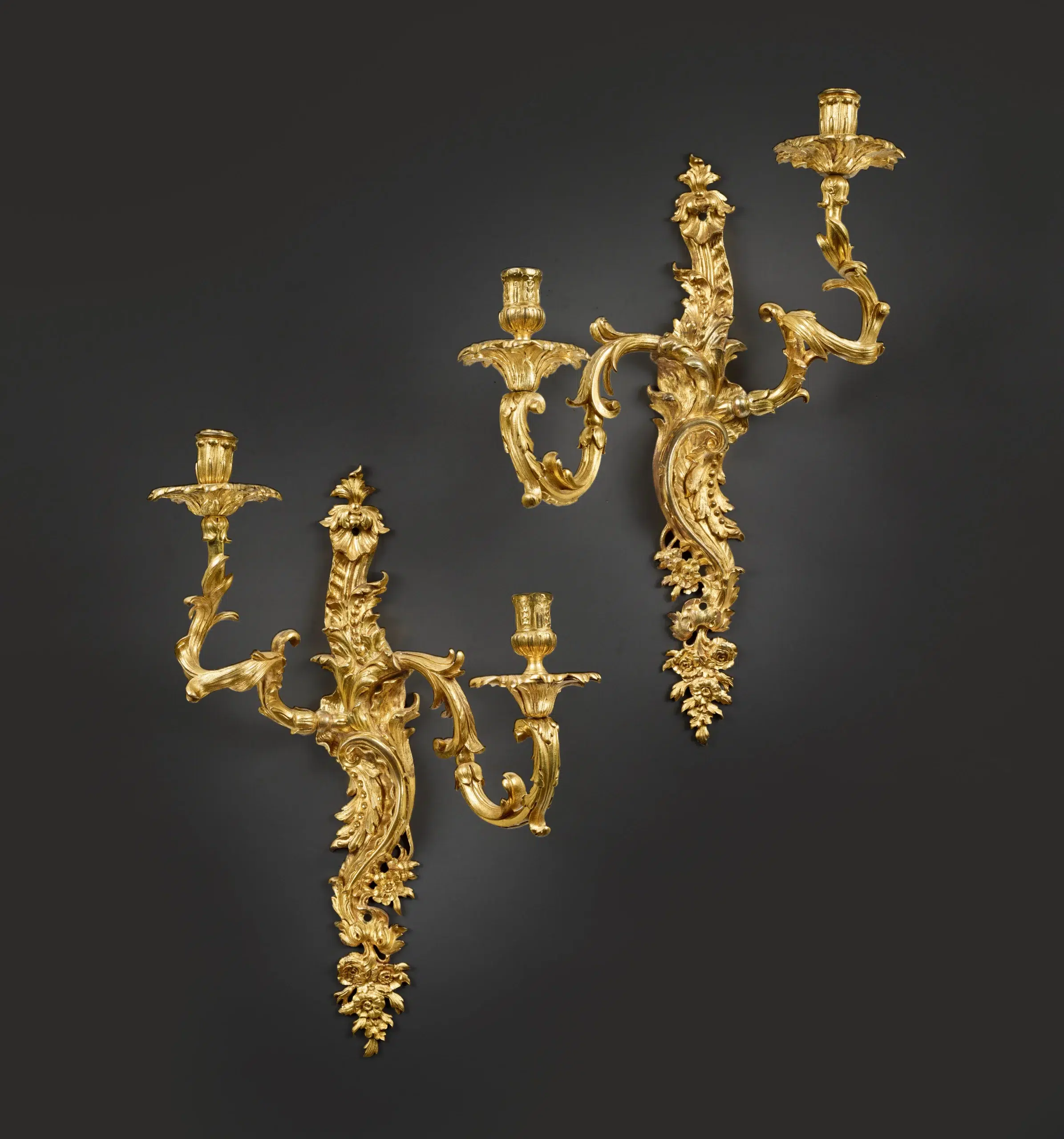France, Régence period, second quarter of the 18th century
Chased and gilt bronze
Close examples:
- Pair of wall lights with two arms, gilt bronze, circa 1735, Los Angeles, J. Paul Getty Museum (inv. 78.DF.89)
- Pair of wall lights with two arms, New York, Metropolitan Museum
- Attributed to André-Charles Boulle, Pair of wall lights, circa 1715, Los Angeles, J.-P. Getty Museum (inv. 97.DF.16.1–2)
These wall lights with their sinuous shafts are richly adorned with flowers, which flourish along their entire length. Their asymmetrical arms of light are made of moving foliage scrolls, emerging from each other. The nozzles and the bobèchesare also made of vegetal motifs and bloom like corolla. The two nozzles of each wall lights are of different shape. The lower one is bellied, with foliage ornaments, the higher one is cylindrical with a gadrooned leave decor.
Régence wall lights
This pair of two branches wall lights is characteristic of models developed under the Régence period, which extends from the death of Louis XIV in 1715 to the majority of Louis XV in 1723 during which Philippe d’Orléans exercised his power. In the artistic language, it however cannot be resumed to few years of presence at the power of Philippe d’Orléans. Extending from the early century to around 1730, it corresponds to a moment of intense creativity.
Marked by the fulfilment of a young and lightened spirit, an artistic revolution initiated at the very end of the 17th century continued then. Since 1699, Louis XIV wrote, in the margins of a project by Mansart for the apartments of the Duchesse de Bourgogne at the Château de la Ménagerie, that there “is something to change, the subjects are far too serious and that it need to have youth mixed in everything that we do”. The lightness and the joy of the grotesques by Jean Bérain (1640−1711) first, created after 1680, and by Claude III Audran (1658−1734), later, open the way for a laughing ornamentation and to twisted shapes in the decor including the gilt bronzes which are a major testimony of it.
The chimney at the time is the principal place of interest in a room, regrouping around it accessories in gilt bronze amongst the most remarkable, such as the firedogs, the candlesticks, or the girandoles, arranged on the mantel, or even wall lights fixed directly on the frame of the glass overmantel.
The numerous objects of art aroused the attention of creators of the time, who imagined a large variety of shapes. The wall lights thus were the object of an abundance of drawings including those of André-Charles Boulle (1642−1732), marked an important point. Known by the engravings of Jean Mariette (1660−1742), after 1707 and before 1730, they contributed to the emergence of a lighter aesthetic where the asymmetrical ornaments were more and more present.
They also corresponded to the birth of a new way of lighting, the plate being then dethroned by the arm, on which branches played a decorative role as important as the fixed element to the wall. Placed on each side of the mirrors, their lights remultiplied the room of a supplementary spark.
Datable to the 1730s, these wall lights were representative of the evolution of the shapes during the Régence period. They recall the principle developed at the beginning of the century associating to a quite discrete shaft arms taking more and more importance. The shaft is here again marked by the aesthetic of the early century, delimited by a straight shape, the desire for asymmetry however showing through the large volute constituting the principal path of the decor already completely Rocaille.
It is thus most essentially the branches that reveal the evolution in germ under the Régence period to the more exhuberant lines, each being treated differently, like the stems of an imaginary plant ending by a bobèche which evokes the corolla of a flower.
The floral repertory, all in lightness and made of small flowers and leaves, treated naturally, corresponds also to the youth spirit which blooms at the period.
Bibliography
- Pierre Verlet, Les bronzes dorés français du xviiie siècle, Paris, Éditions Picard, 1987.
- F.J.B. Watson, The Wrightsman collection. Vol. II, Furniture, gilt bronzes, carpet, New York, Metropolitan Museum of Art, 1966, p. 405.
- Gillian Wilson, Decorative arts in the J.-Paul Getty Museum, The J. Paul Getty Museum, Los Angeles, J. Paul Getty, 1977, p. 29.
Measurements:
- Height: 46 cm – 18 inches
- Width: 36 cm – 14 inches
